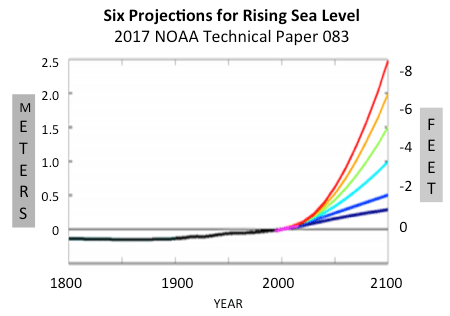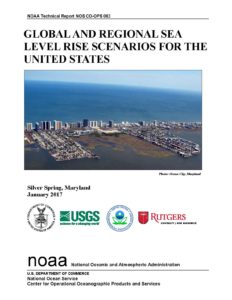NOAA Sets New Sea Level Upper Limit To Over 8 Feet

New Technical Report from NOAA released 1-19-17 adds an even higher “Extreme Sea Level Rise Scenario” (red line), recognizing the possibility of as much as 8.2 feet (2.5 meters) this century as a global average, with certain locations even higher. (NOAA NOS CO-OPS 083)
Last week the National Oceanic and Atmospheric Administration “NOAA” issued a new 44-page report, “Global and Regional Sea Level Rise Scenarios for the United States.” They have created a new projection line for as much as 8.2 feet (2.5 meters) by 2100, the red colored line shown above, based upon a comprehensive assessment of the latest science primarily focused on Greenland and Antarctica. Eight feet of higher sustained sea level will be catastrophic for almost every coastal community in the world.
 For the past five years, I have been warning that sea level rise could be dramatically higher than the usual scientific references, such as the IPCC Report (Intergovernmental Panel on Climate Change). See my post “The Elephants of Antarctica and Greenland”, for greater explanation. As scary as this 8 foot scenario is, here are some other important points that should be noted:
For the past five years, I have been warning that sea level rise could be dramatically higher than the usual scientific references, such as the IPCC Report (Intergovernmental Panel on Climate Change). See my post “The Elephants of Antarctica and Greenland”, for greater explanation. As scary as this 8 foot scenario is, here are some other important points that should be noted:
- 8.2 feet is the global average projection. In certain areas that amount could vary significantly–as much as a third more, or less. (Regional variations result from land subsidence/uplift, ocean currents, and the redistribution of the Earth’s mass, as Antarctica and Greenland melt.) For example, the Northeastern U.S. is estimated to be about twenty five percent above the global average, bringing their upper limit to roughly ten feet above present by 2100.
- With only 14 inches (35 cm) of higher sea level, most locations will have 25 times more frequent flooding than present. That could occur within just two decades.
- In some locations such as South Florida, just six to eight inches of higher sea level will have major consequences such as salt water intrusion on the water table, or affecting wastewater treatment and drainage systems.
However, even the eight foot scenario is not a true upper limit. As the melting of Greenland and Antarctica continues to accelerate — as many of us believe it will — even higher sea level rise is possible by the end of this century. In other words, we can expect another curve to be added above the red one at some point — perhaps a magenta line. Furthermore, whatever level it reaches this century sea level will continue to increase throughout the next.
What makes this so hard to accept is that we have never had this level of sea level rise in all of human civilization. The last time sea level was higher than present was 120,000 years ago. Then it reached about 25 feet higher than present (7-8 meters). Based on the current temperature levels, we will almost certainly reach that height. The question is how soon. That does depend on how aggressively we work to reduce the level of greenhouse gases – largely carbon dioxide. In all my talks and briefings, I try to leave two takeaways:
- To slow rising sea level and the other effects of climate change, we must reduce greenhouse gases as quickly as possible. However, regardless of the fact that we can slow the rise, we can not stop it in the coming decades. The ice melting and the sea rising have passed a “tipping point” and will continue for centuries.
- We must begin planning and adapting to higher sea level NOW! That would be the smart thing to do recognizing the new record flooding in coastal areas, as a result of more severe storms, record rainfall, and extreme high tides, all compounded by rising oceans.
A few places are beginning the process to look at how to adapt to higher sea level — in fact there are dozens of communities around the US and globally that are starting to take this huge challenge quite seriously. This new NOAA Report and the 8 foot red line should add urgency to begin the process and to think ahead — so that our investments in buildings and infrastructure are truly good investments, ones that will protect us today and be a good foundation for communities of the future.
